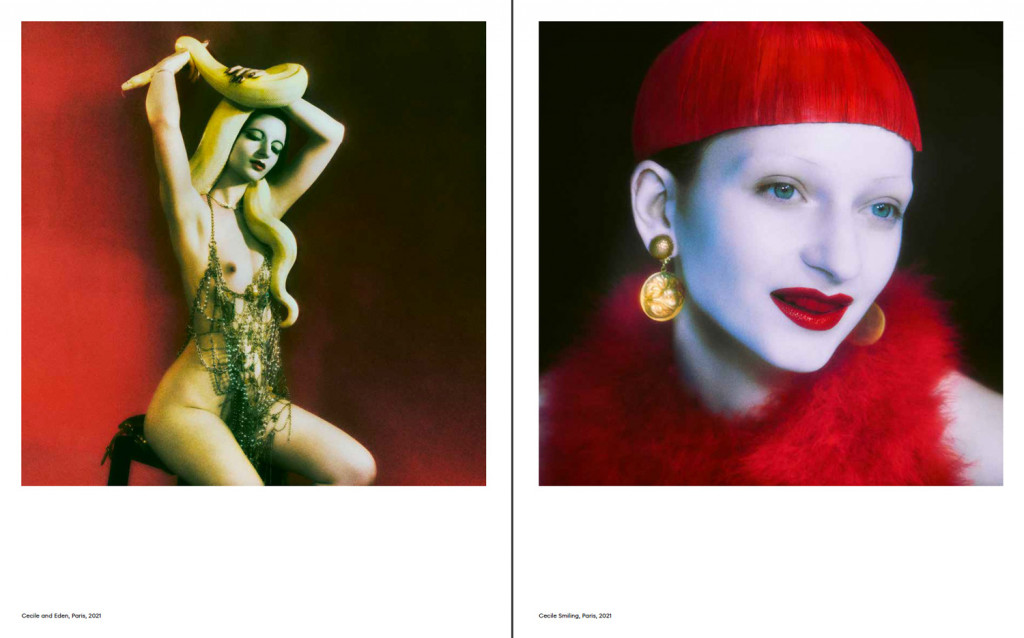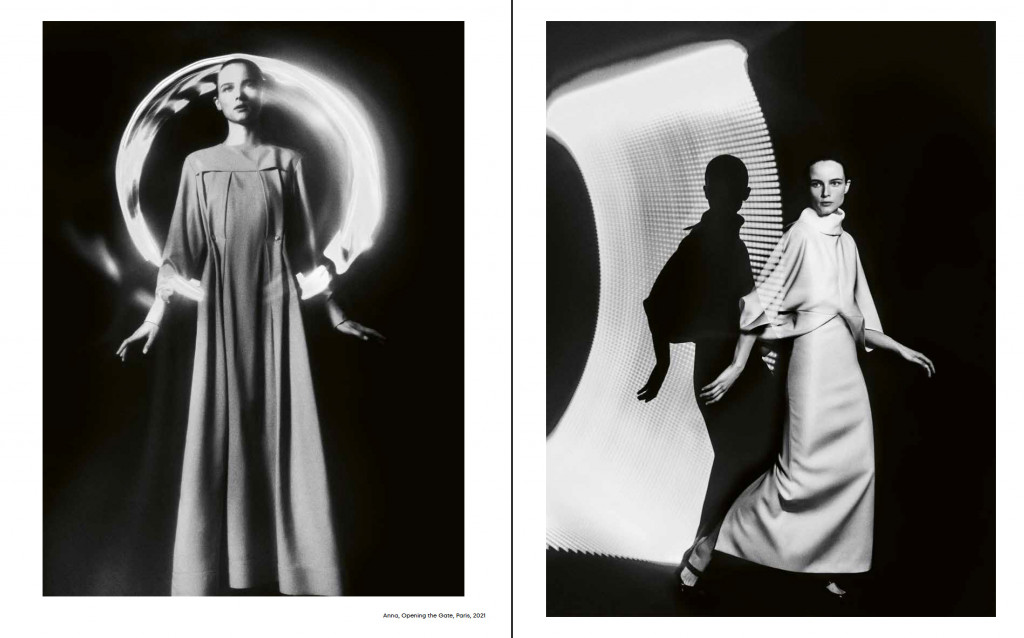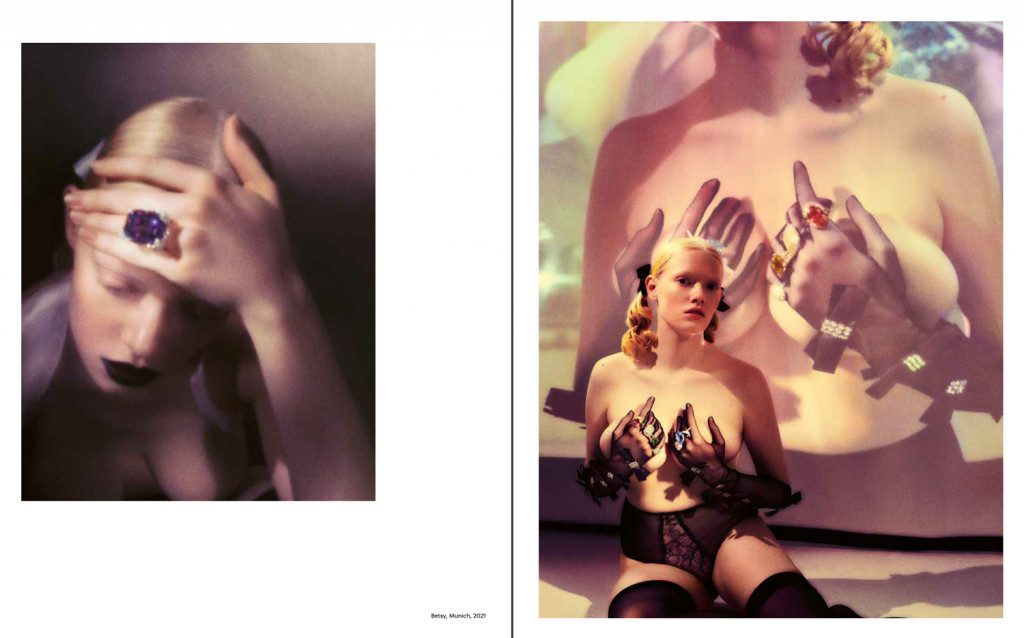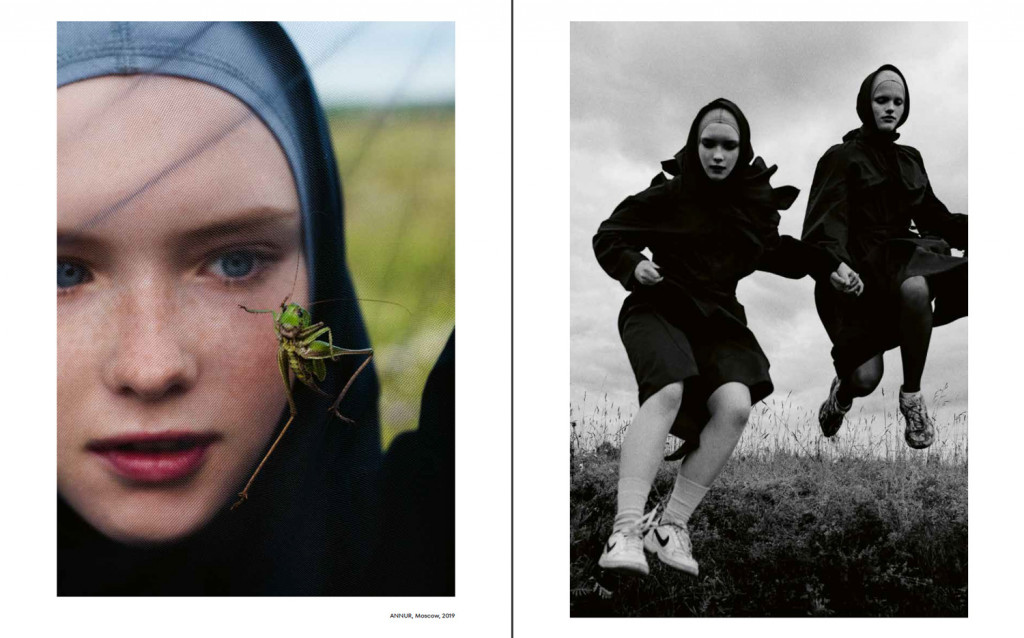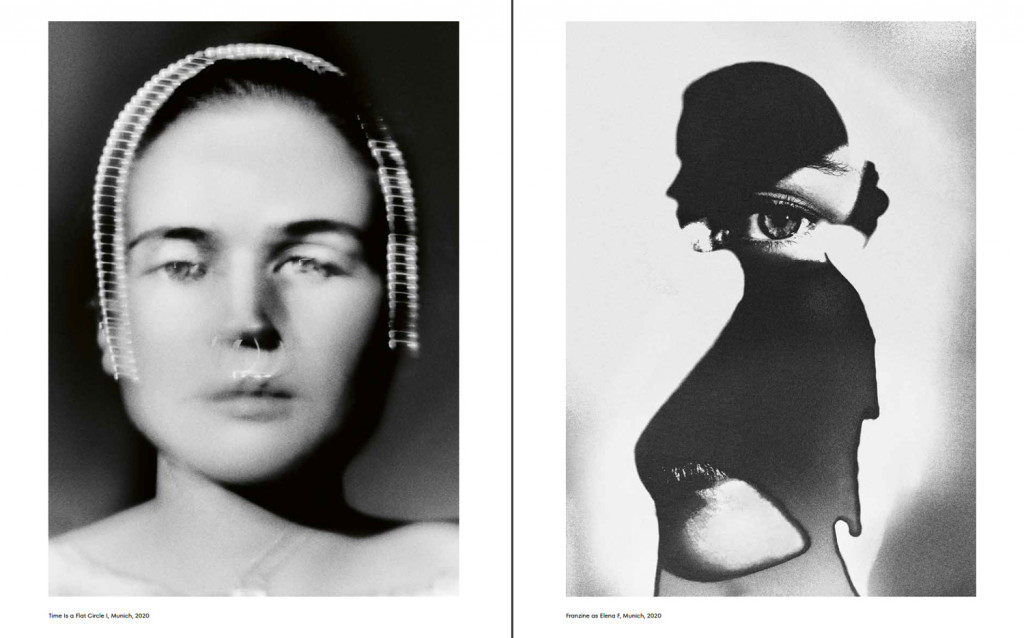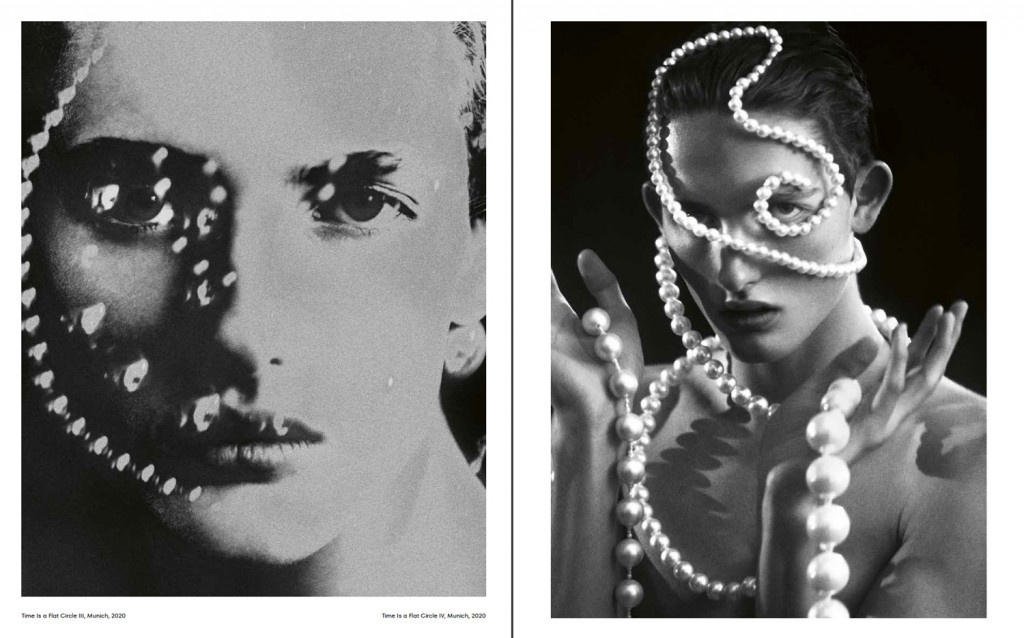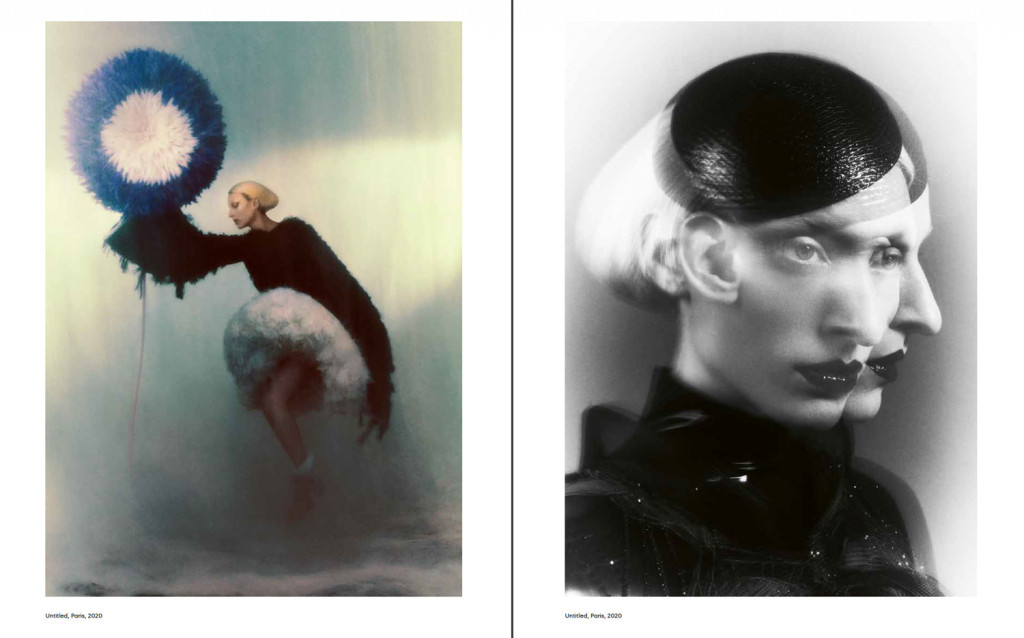Podcast / Interview
Elizaveta Porodina
32 min talk
Our guest today is Elizaveta Porodina, a Russian artist and photographer based in Munich. She’s worked for Vogue, Dior, Carolina Herrera, Vanity Fair and others, just opened an exhibition in Stockholm at Fotografiska, and is now publishing her very first book.
Hi Elizaveta!
Hello!
Nice to have you here. You’re talking to us today from Munich, where you live, and you just opened an exhibition in Stockholm. How did that go?
Thank you for having me! The exhibition went fantastically well. There was way more of a response and buzz than I expected. There were three days of interviews, guided tours, opening lunches and brunches, dinners, and above all the exhibition itself, which shows 150 pieces of my work of the last three years. It is just so fantastically curated; I felt really honored and overwhelmed looking at the huge prints of my work. As I work digitally, sometimes I never get to see them printed, so when I stood in front of them, curated like that, it was really overwhelming, in the best sense.
It must be very different than doing advertising or editorials for magazines.
Yeah, sure. We can get to the question of separation of work later. Just to premeditate it: I generally don’t make a big separation in my work in terms of whether I’m shooting advertisement or an editorial or a personal project. I’m equally dedicated to all.
That would have been one of my questions actually, if there is one realm where you feel most at home, if you see yourself as a fine art photographer or a fashion photographer or you don’t distinguish…
I think we can cover that now then. I’d say that I’m an artist. That being said, I think that the term of an artist in my head is a very democratic one. I think that everyone who decides to be creative, to pick up a pencil, a crayon, any sort of medium, is an artist. And I am one. I love creating, I need creating, I survive through creating. And in terms of separation, you know, I really don’t. I go into a job, I may get paid money for my time, just as motivated, just as fervent, just as ambitious as when I go into a project I invest money into myself. I think any sort of work always has limitations. There is no need to have this illusion about personal projects being a limitless paradise; there are limitations there as well. I think the task of an artist is to deal with all the limitations and solve creative problems and turn them into something pretty.
It actually really struck me when I looked at your Instagram and portfolio and scrolled through the images – I couldn’t make out what is an ad, what is for an editorial, etc. It felt almost like one homogenous series.
Thank you!
You have a lot going on, not just this exhibition but your first book is coming out, “Unmasked” is the title. How excited are you?
On a scale from 1 to 10 it’s a subtle 12. I’m very excited. I have been waiting for a long time to publish a book. It never seemed right. When it has a character of a retrospective, it makes you feel like you’re already dead. So I didn’t want that. When the exhibition happened and I was approached by the publishing house Hatje Cantz, and they wanted to publish a book about the project, I felt like it is the right moment. It’s tied in with the exhibition that is sort of looking back on the last 3 years, which have been very decisive for my career and really showed me how important it is to be unapologetic and be radical and believe in yourself, for what that sentence is worth. I just wanted to capture this feeling into something that is less fleeting than social media.
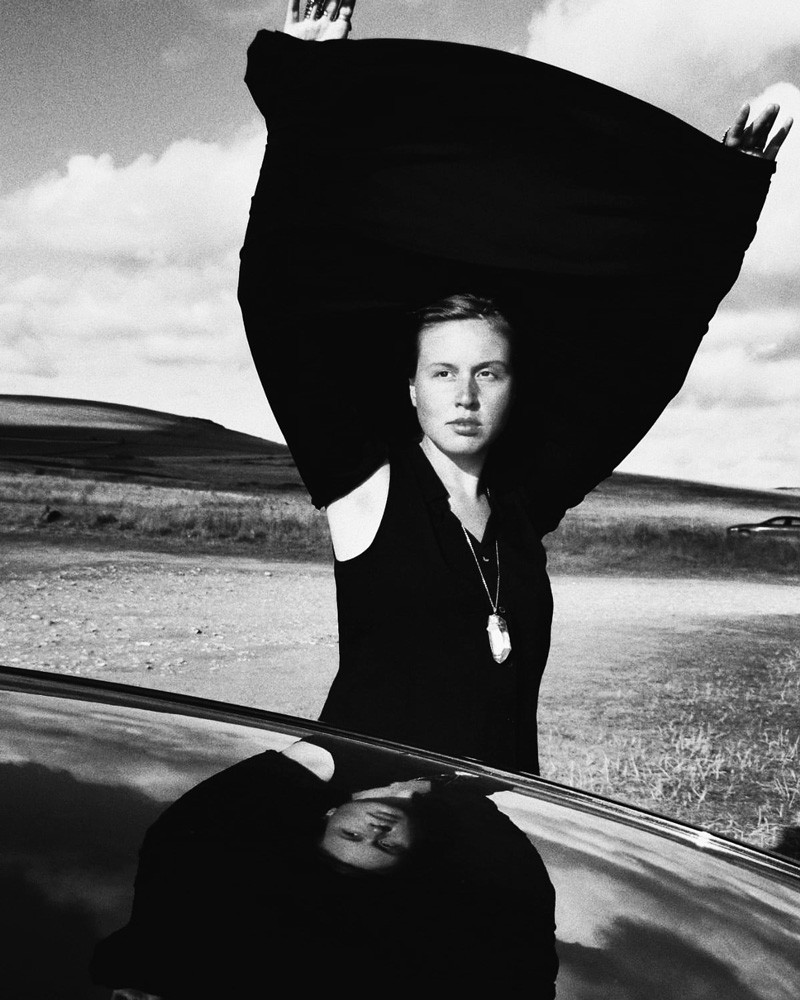
Some people might wonder why still make books in the time of TikTok and all these proclamations of “Print is Dead”.
Print is obviously not dead. I think what is maybe dead are some things that weren’t necessary in the first place, or that maybe have evolved into something different. Books for example or special magazines are a luxury, and luxury has never been needed by anyone. It has been wanted. Products of luxury and enjoyment. I’m obviously not speaking about books in general. I’m speaking about photo books. It’s just enjoyment. It’s beauty. It’s something that people will always want. To hold something in your hands that you can smell and feel the weird texture of the paper and look at the colors, the way how they shine back to you. I was never worried about that. And I think it just gives you a different way of experiencing how different artists work. If I feel that way then other people will as well.
A lot of photographers - it’s almost a bit of a movement I feel – they self-publish. Did you ever consider this? To do it independently?
Not seriously. I feel very challenged by being focused on multiple projects in different disciplines. I feel publishing is a different discipline to photography or being this visual artist, which already means having expertise in many different areas. Being a photographer, being an artist, nowadays, who also works on commission, doesn’t only mean being an expert in taking pictures, it’s also being an expert in retouching, in marketing yourself, in managing yourself, you have to be an expert in the market you pick, you have to be communicative, really good at many levels. So when it comes to publishing, I just always felt it’s one skill too much to learn. And I do enjoy the collaborative aspect of it as well as having a certain reach that comes with doing it with a publishing house.
What was the working process like? Did you work together, or did you submit your images and they took over?
Not at all. Au contraire. It was me and the curator of this project, Nadine, and the designer that I was working with, Julia Wagner. We all worked very closely together, and it was an incredibly collaborative process. We were making every decision together in the best way possible. It felt very intimate, like they were helping me curate my diary. I couldn’t stand behind the project more to be honest.
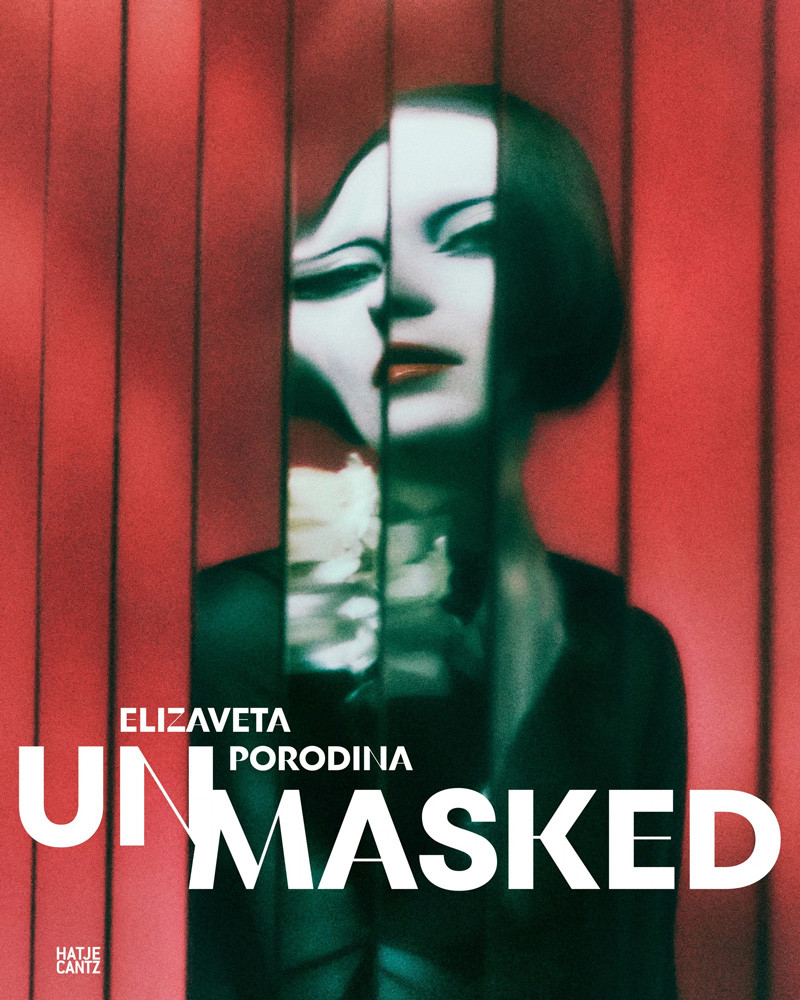
Hardcover, 160 pages, with a foreword by Fabien Baron.
❯ You can buy the book here
Sounds perfect. Was it difficult to choose which photographs to include? Your archive must be quite massive.
It is. And at a certain point you’re right. I would say that it was kind of easy to come down to a number of 300 or 260 or something like that, and from that point on it just felt like slowly killing my darlings. There was a point when me and Julia were looking But that’s impossible right now because of a paper shortage due to our favorite topic, corona. We managed in the end and I feel like it made the edit much sharper than it was before. I cannot stress enough the necessity of editing yourself. I want to say one thing loud and clear: you have to choose fewer words, and they have to really sit.
Did you have certain criteria or did you rather follow your gut? How do you make choices like that?
Both of these things, combined with my experience of how the images did when they were published. I’m a huge fan of publishing my images and showing them to my audience. And it’s not that it’s my only criteria but I do feel that there is a certain beauty in the way how the images communicate with an audience online. You sometimes see a special response and I don’t necessarily mean the amount of comments or likes etc. If it provokes more thought than other images for example. I have been a fan of publishing my images online from day one of me being an artist. I remember when I moved to Germany I immediately started painting and drawing to cover up the desperation of not knowing the language and not being liked by my co-students. So I started drawing and I immediately started publishing my images and posting them on a self-created website. And the first comment I got was ‘No offense but why are you posting something so ugly?’
How did you feel?
Not great obviously. But it kind of taught me a lot, publishing myself. It is a great way of communicating, a great way of seeing whether your work lives or whether it has something to say in a way. And again, it’s not about Instagram , it’s not about social media, it’s just about … it can also be an exhibition. Like when I did my exhibition, seeing the response to your work, and the way people start moving differently, where they stand still, in front of which piece of art, how they respond to it with their gaze, how their eyes move back and forth, I find it a very interesting piece of information. Every artist is different but I have always been about finding a way of communicating with other people out there. Because no other way has been efficient for me, including words. I’m good at speaking but not necessarily the best at picking up verbal or non-verbal signals. To me, my art has always been my way of saying my truth.
Would you say that these responses or reactions influence what you do or how you work in the future?
Not in this easy way that you might imagine. It’s not like ‘This picture has a lot of response, I’ll just take another picture like that.’ It’s the criteria that you mentioned before, with this other criteria added, plus reacting to how I feel during the shoot. Sometimes people really dislike a direction, and you could just keep going further because you feel like ‘Wow, they still don’t get it, so I’m just going to do more of that.’ Which I do often enough to be honest. I like keeping people on their toes, and myself as well.
I spotted a photo that you took that’s also going to be in the book, of Chloe Sevigny. The caption explained that it was shot during the lockdown via Zoom in New York in 2020. How did this work exactly?
Maybe you spotted this Zoom caption on other photos as well. There is a number of projects that I conducted via Zoom during the first lockdown of 2020. The project with Chloe was the first one, and I think that over the course of the year I did maybe 50 projects over Zoom, shooting in various countries. The projects ranged from shooting in a very intimate condition where it was just me and my husband on this side and then another person on their phone on the other side to me and my husband here, and 200 people on the other side, because we were shooting the cover of Vogue China and it was a massive production. Everyone was wearing their masks and shields of course. It was a technology that we developed during lockdown because we were obviously sent home when everything was shut down. I was so full of energy and so full of interest to keep going and discovering and making art which is the most important thing for me and my life, so I just wanted some sort of solution, and we sat down and we called our friends, who are some of our muses, and we started trying out different techniques, like many other people at that time. There were a lot of Zoom projects. We just stayed very persistent and ambitious. I didn’t want it to be this sad compromise, I wanted it to be my new tentacle of work, and wanted it to be even better than my other stuff, if that could be possible.
I might sound very stupid right now, but can you explain to someone who’s not into these technical details of Zoom photography – who presses the shutter?
I understand your interest, but I obviously prefer to keep the details to myself. I feel like it’s a unique technology.
»I cannot stress enough the necessity of editing yourself. I want to say one thing loud and clear: you have to choose fewer words, and they have to really sit.«
Elizaveta Porodina
Ok, I didn’t know that. Fair enough. It’s very intriguing.
Thank you! In the exhibition they have this amazing shining quality to them because they’ve been printed really big and I didn’t know if they could survive that, but they shine even more. It’s really charming, I really like it.
Let’s go back in time a little bit. How did you discover photography as your medium of choice?
I have always been doing or making art in some way. I already told you my sad story about starting to paint and draw. I started doing that when I was 7 and then it kind of intensified when I was 13, and my family moved to Germany, and I was coping with the consequences of that. I kept doing that till I was 22, 21, and I started studying clinical psychology. I kept it as some sort of hobby, but there was this passion and ambition lingering in me, that I would still be an artist, but I didn’t know that it wouldn’t be painting. I felt very isolated…to me, painting wasn’t this absolutely fulfilling thing as a twen, it felt more like isolation and hiding. I strived to find something that would challenge me more as a person. I picked up photography by coincidence.
An ex-boyfriend was interested in photography and shot animals and ducks at the zoo, and I thought maybe that could be something. I picked up the camera and started photographing my friends, at night, during parties, or just randomly any sort of situations, and apparently the photos were good enough to attract the attention of some young designers, who were interested in me shooting their campaigns and lookbooks. This meant absolutely nothing to me back then because I didn’t even know the terminology.
I didn’t understand anything about fashion. I just stupidly agreed to all of these things, not knowing how much of a challenge it is. The challenge didn’t bother me. I wasn’t unhappy, I wasn’t overwhelmed, I wasn’t terrified when I learned that I have two locations available and it’s artificial light and five models. I actually was absolutely excited about these things, I was so happy. I felt almost like I was high. I didn’t want to eat, I didn’t want to drink, I was just rushed by this incredible amount of adrenaline. I think I felt like this for the first time in my whole life. I just decided that I needed to keep doing it. Before that I was a deeply unhappy person who was just running on 20% of my usual capacity.
You just found your thing!
I think that’s the easy and short way of saying what I just said, yeah (laughs)
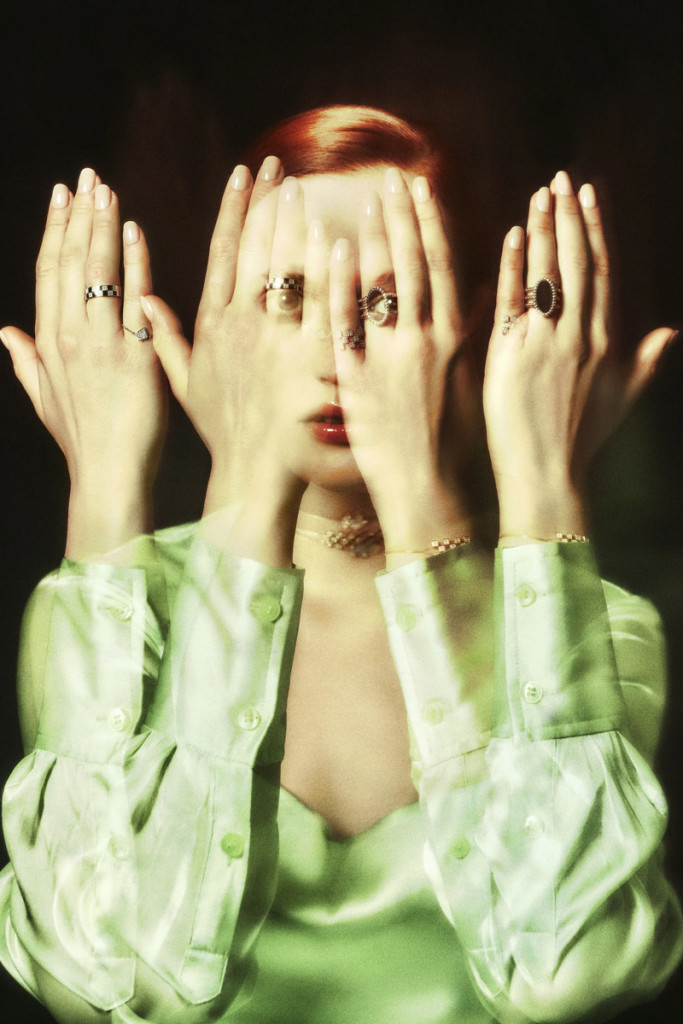
So you’re self-taught as a photographer? You didn’t study it, you learned everything yourself?
Yeah, I studied clinical psychology and I worked in a psychiatry for one and a half years while I was still learning some photographic skills. I did learn all of the things that I know now by myself but also with the help of mentors along the way, and also with my husband who is my lighting technician, light director.
It can be a difficult industry to access. How did you do it? Do you have any advice for photographers starting out?
I also found it very difficult to access. I had this run-in with a photographer roughly ten years ago and everything he said struck me and kind of stayed with me for a long time because it is so true. He said the world of fashion photography is basically one table, and there are 12 chairs around it, and whoever sits at this table gets the good bits and everyone else kind of scratches from below. Which, back then, I found really dramatic, and unnecessary, and also very demotivating at that time. I barely knew anything. The more you move forward the more you learn about these unspoken and unwritten rules. Nobody speaks about them or writes them down. It makes you feel a lot of things. You can be sad one day and then very motivated the next, and then completely desperate the next day. It’s not an easy industry to navigate because you meet a lot of beautiful, creative, interesting, unique people. But you also meet a lot of people with genuine narcissistic personalities, and you see a lot of political games that you never want to be part of and where everything is out of your control.
You become part of decisions that you never… it’s just pretty much everything, a slice of life. You have to really really want it. It’s very important to understand as early as possible what you actually want, and how much, on a scale from 1 to 10. I would never ever advise anyone who doesn’t want it 12 out of 10 to do it because otherwise you’re not going to be in for a fun ride. It’s only going to be a fun ride if you cannot do otherwise, for the love of photography, for the love of art. Your motivation has to be purely a passionate one.
Otherwise you would probably easily have given up, with so many roadblocks…
Maybe, or it’s just not going to be a lot of fun. Because you will secretly ask yourself, well, this is some bullshit, why have I signed up for it, and the answer to that question has to be ‘Because I love it. Because I cannot do anything else’. No matter how badly people treat you, no matter how much they underestimate you, no matter how much you invest and how little comes out of every step, you must still be able to say every night when you go to sleep ‘I would be doing it anyway’. That is the premise in my head. But maybe I’m just being very dramatic.
You’re living in Munich, which is not really one of the super big fashion capitals in the world. Did you feel it was a disadvantage?
You don’t necessarily have to live in any of the fashion capitals. It’s practical, because many of the productions happen there. You just have to visit and you have to have relationships there because this is how it works. You have to have your network, your people that you like to work with, that make your art better, that really support you and believe in you. It can work when you don’t live there if you go often enough. If you don’t go there, and if you don’t have any relationships there, don’t hope for anyone to discover you. It won’t happen.
And how did you build these relationships?
Well, by trying really hard. It’s just like everything in life, you go out there, you make a list of people that are interesting to you and that you find inspiring, and you present your work, which as to be credible at this point and amazing, the best you can do, and then you hope for a response. And then as soon as there is an exchange, you keep this going. My biggest advice to anyone is to be genuinely interested, don’t fake it, don’t try to build meaningful relationships with people that are not inspiring to you, that you don’t genuinely like. It doesn’t make sense. You have to really want it. And then you will create longterm meaningful bonds with people that you respect.
Back to your photos – you already mentioned you used to paint and a lot of your images have a painting feel to them. Does a lot of work happen after the actual shoot? Do you use a lot of after effects?
A lot of people actually assume that firstly I shoot analogue and secondly they assume that I’m doing a lot of post-production. Both of these assumptions couldn’t be more false. I shoot digital and I would say that a lot of people who worked with me can tell you that it just happens, this is how they come out from the computer. Maybe I do clean up some threads if they hang out of the garment or little bits here and there but it’s not the type of post-production that you would imagine, I’m not painting the whole thing afterwards.
So when you go to a shoot you’re super well prepared and you know exactly which result you want?
Well, no. I’m very well prepared, yes, preparation and pre-production are incredibly important, and the more everyone is in the same flow, and the more everyone responds, and beats the same drum, the more it will get to that point where everything is unison and everything has this fantastic wholesome effect that you noted, right? If it comes down to why the images look like this, I think it’s the color composition, the light composition, choosing the right person for the right thing, it’s combining the right clothes with the right lighting with the right hair, with the right make-up, with the right attitude. And then being able to make the right decision about the colors. It’s a lot of rights for one shot. And that comes with some sort of expertise first of all, and then also with the right team, and with the right flow, if you’re so lucky, and with a lot of dedication. I sometimes sit hours, days, finding the right image, and treating it in the right way.
You really have your own style. It’s very distinguishable. Was that a long way to get there, to find your very own thing?
It was a short way with a lot of distractions. Because I feel like the actual style, the style that I am doing now, it’s just my voice. I’ve never done anything different in my whole life. It’s what I have been doing since I was a little kid, when I started painting, with crayons, that’s exactly what I was drawing, this sort of mix of something magical, something mysterious, with something scary, with something hysterical with something larger than life. It’s always what I’ve been interested in. When I started photography, it was the same. The same passion, the same interest. Studying the dark side a little bit, but also being on the side of ‘more is more’ and things like that. There was a certain moment in my life where I felt like, you know, ‘is that it’? Is that just it? When you’re also not necessarily being surrounded by the right collaborators anymore who could support the growth and the development of that medium in the right way, to make something new, something modern. I kind of had this detour to other things for quite a long time, for many years, where I just tried out completely different things, was only shooting in available light, for magazines that I don’t shoot for today, and just trying out different things, and doing the things that I do now, which I present in the exhibition and in the book. They really feel like coming home, if that makes sense. Just coming back to my original voice but even harder.
Do you have any idea what’s next for you? Are there still things that you dream of doing?
Yes. The name of the project I do want to keep private because it’s something that I’m still working on and I don’t want to jinx it, but there is a certain topic that interests me from my former position as a clinical psychologist. I want to put multiple people in the same situation and explore how they respond emotionally to it and capture it photographically. So I want to combine my previous profession even more with my current profession.
We’ll be very curious to see the result.
Thank you!
Elizaveta Porodina was interviewed by Sarah Schug
Discover more Photography Podcast
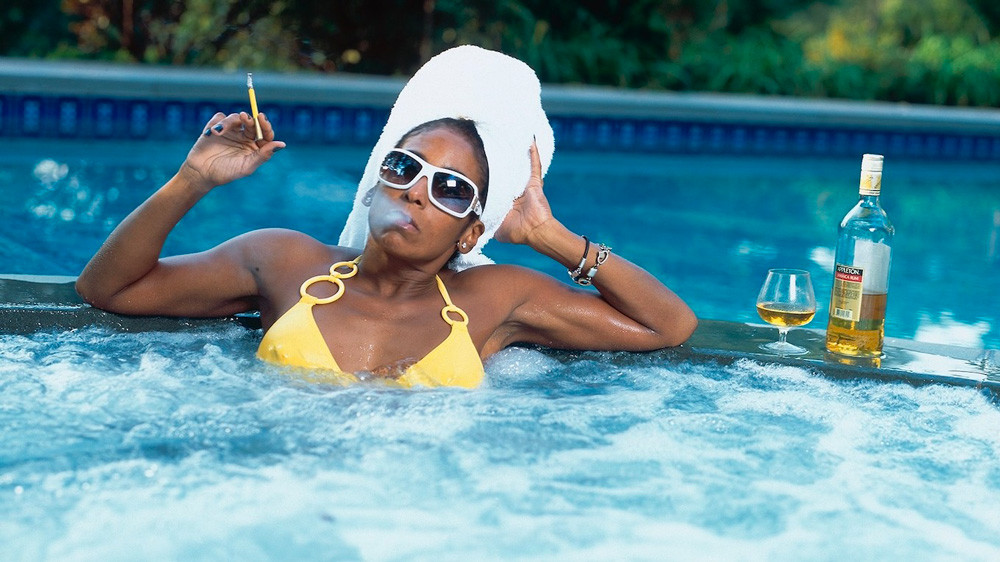
ART SEASON
The top 7 summer photography exhibitions 2022
While most galleries close down for the holiday season, museums and festivals seduce with attractive summer programs. We’ve selected seven must-see exhibitions in photography industry hotspots Berlin, Los Angeles, London, Paris, Hamburg, and NYC for those who need a break from the sun.
READ MORE
Podcast
Fashion photography podcast and interviews
On no particular schedule, we publish photography podcasts providing useful glimpses into an industry that can feel hard to penetrate at times. Through personal stories and experiences our guests, which range from booking directors, creative directors and agency founders to established and emerging fashion photographers and stylists, take you with them behind the scenes.
READ MORE

